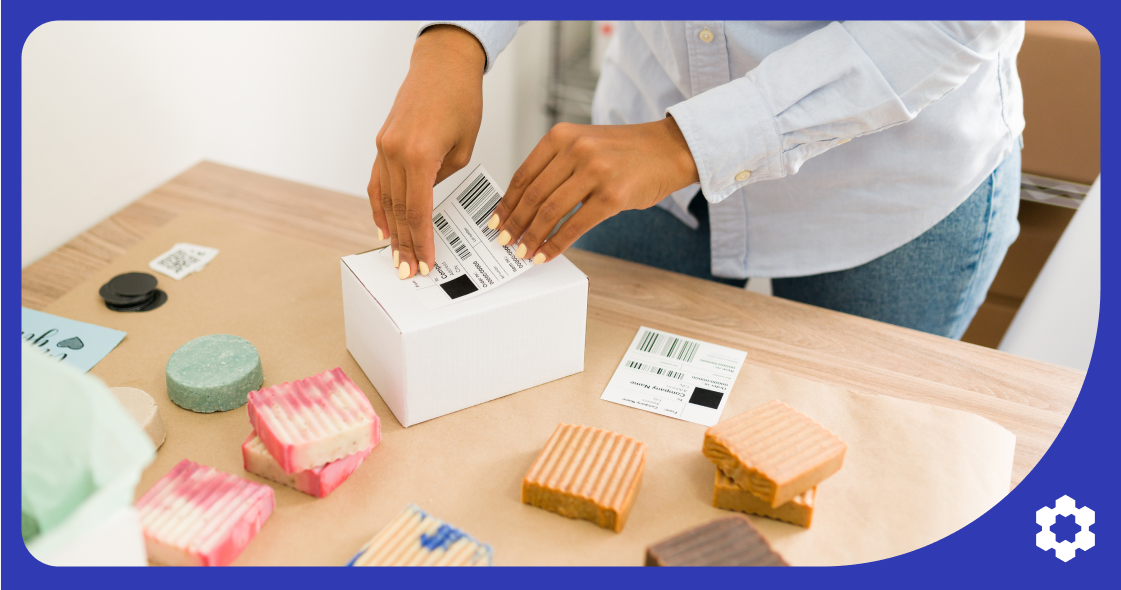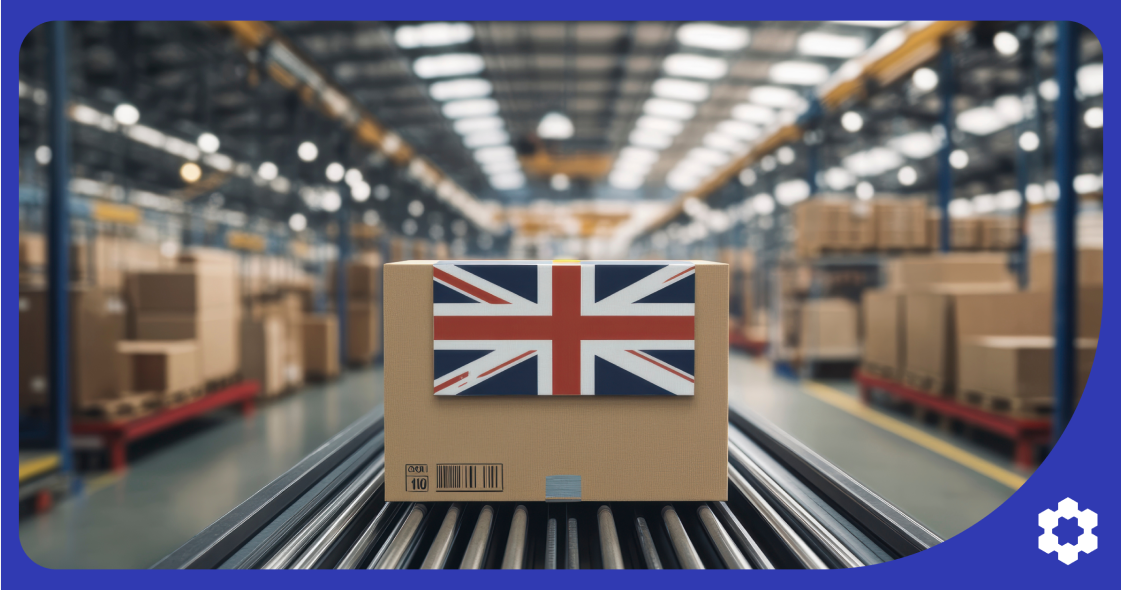Listen to This Article
As if there weren’t already enough to oversee running a successful Amazon 1P Vendor operation, throw in issues such as late shipments, incorrect labeling, improper packaging, or other non-compliance violations which can lead to chargebacks, and you have yet one more factor that needs to be accounted for in order to keep your 1P Vendor business profitable.
The good news: when those chargebacks occur they can be disputed, and, with the right strategies, recovered nearly every time.
Key Insights
Need-To-Know
- If you believe you’ve been charged incorrectly for non-compliance, you have up to 30 days from the notification date to dispute Amazon vendor chargebacks.
- To submit a second dispute for the same chargeback, you have 30 days from the first refusal notification.
- There are specific steps to follow to submit a dispute.
What’s Involved
- Review the chargeback details
- Gather supporting evidence
- Submit a dispute
- Monitor the status
Prevention & Automation
- Taking steps to prevent chargebacks is half the battle.
- Consider partnering with an expert to oversee and manage your chargeback disputes.
- Recovery of 75% of fees, Amazon shortage claims, and accruals can be automated.
What are the most successful ways to dispute Amazon vendor chargebacks? More than that, is there a way to automate the process?
Chargebacks are a beast all their own and can be a very steep learning curve.
Chargeback Challenges and the 1P Vendor
Some have likened chargebacks to death by a thousand cuts; lots of small charges that represent a significant impact on profitability. Fortunately Amazon has a system in place for vendors to dispute them. More importantly, there are proactive steps vendors can take to reduce chargeback frequency and minimize losses.
But that all begins with knowing where to start and what to do. Yet one more of the many challenges vendors face.
Without an awareness of how to prevent chargebacks and, crucially, the steps to take to reverse them, Amazon 1P vendors can lose significant revenue. Once chargebacks have been incurred it’s up to the vendor to file a dispute.
With the right strategies and solutions vendors are able to get most of that back.
Note: Gain visibility into potential revenue recovery. Request a complimentary audit to identify unclaimed profits and ongoing loss exposure.
“Carbon6 has taken the frustration out of deductions resolution and equipped us with tools and insights to drive continuous improvement initiatives on the Amazon account.”
~Sanofi | Global pharmaceutical company
Types of Chargebacks
Categories of Amazon vendor chargeback types can be grouped according to the different stages of the vendor-Amazon relationship. At each stage there are certain expectations, which, if not adhered to, will earn the vendor a chargeback from Amazon.
Though there are 40+ types and subtypes, all fit within six (6) main areas. Chargebacks are initiated due to problems with:
- Purchase Orders (POs)
- Advanced Shipment Notification (ASN)
- Preparation
- Packaging
- Transportation
- Receive Process
Once a chargeback occurs it’s up to the vendor to understand and dispute it.
Steps to Dispute Amazon Vendor Chargebacks
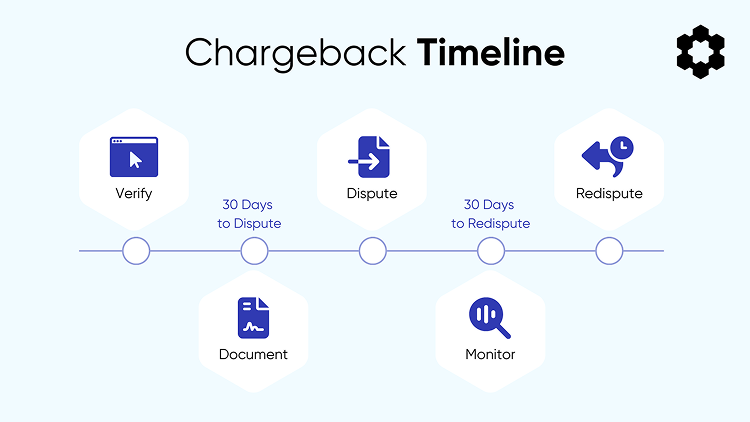
Successful mitigation/management of chargebacks comes down to two things:
- Prevention
- Recovery
Let’s start with #2, outlining the steps you can take to dispute and recover chargebacks once they’ve been levied. These are steps you or your team will take to dispute Amazon vendor chargebacks, with the goal of reversing them and recovering funds. Automated options exist, which we’ll cover below.
The first thing to know is that you have up to 30 days from the notification of a chargeback to dispute it. You can do that twice, with another 30-day period available after the first refusal.
A chargeback is triggered for a non-compliance issue. As with most Amazon systems there is a dispute process in place.
Disputing a Chargeback
Follow these steps to verify, dispute, and track the status of chargebacks.
Verify
- To review defects that triggered chargebacks, go to the Operational Performance dashboard in Vendor Central.
- Next to Total in the upper right corner, click View All.
- Search the chargeback by keyword, name, or product ID, and select one or multiple chargebacks that you want to dispute.
- On the chargeback page, confirm that the Dispute button is available.
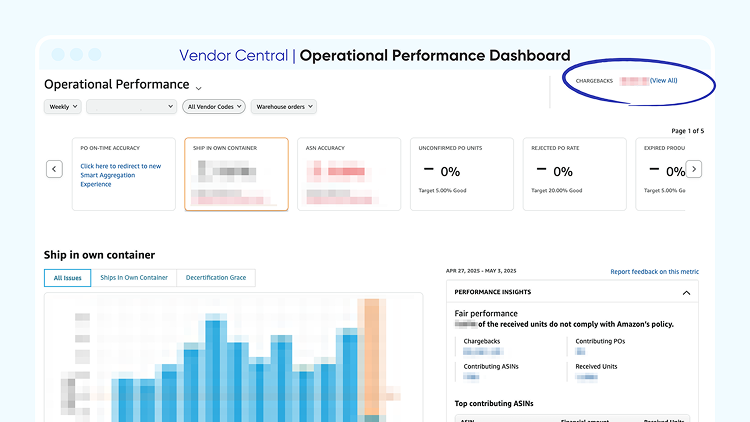
Dispute
- Begin in the Operational Performance dashboard.
- Next to Total in the upper right corner, click View All.
- Search the chargeback by keyword, name, or product ID, and select one or multiple chargebacks that you want to dispute.
- Click Dispute, and follow the instructions.
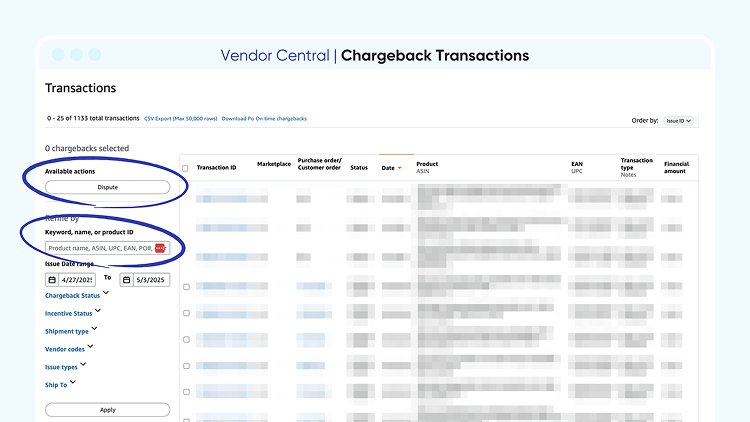
Status
- Check status from the Operational Performance dashboard.
- Next to Total in the upper right corner, click View All.
- Search the chargeback by keyword, name, or product ID, and select one or multiple chargebacks.
- Check the status of the dispute: approved, pending, or rejected. For more information about statuses, go to Chargeback dispute statuses.
- Once you click the chargeback ID, you can also view the dispute history.
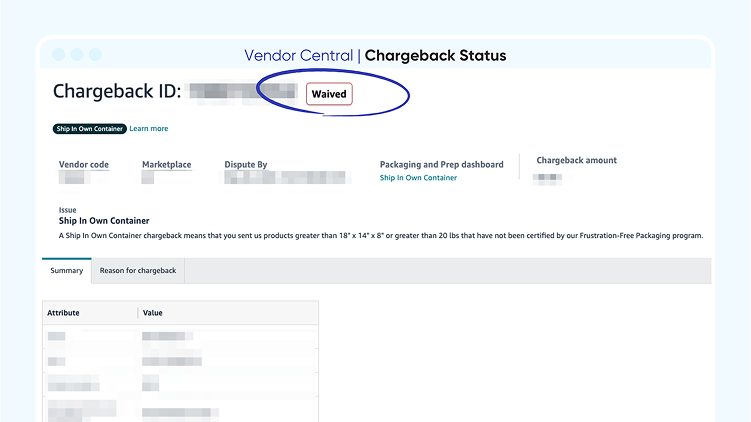
Status Types and their meaning:
- Charged: This means that you’ve already been charged for the chargeback. If you think you’ve been charged in error, go to Dispute a chargeback, and follow the dispute process.
- Under Review: The chargeback is pending status
- Reversed: The chargeback is being reversed and you’ll receive the payment in the next payment cycle.
- Waived: The chargeback is waived, and you have not been charged.
Of course, not getting a chargeback in the first place would be the ultimate solution.
Avoiding absolutely all chargebacks may be unrealistic, but that’s the brass ring you should be aiming for. The best way to hit that mark (or come damn close) is by thoroughly understanding the things that can trigger a chargeback, then using that knowledge to be as proactive as possible.
An Ounce of Prevention
In the end chargebacks come down to issues that, in most cases, can be avoided. Is your packaging up to standards? Have you followed all guidelines for shipping and labeling? Attention to these things makes the difference.
Knowing Amazon’s guidelines is Step One. Applying those guidelines to your operational flows is, of course, the most important thing you can then do. We recommend the following basic actions as part of your SOPs:
- Stay compliant: Ensure you’re following Amazon’s guidelines for shipping, labeling, and packaging.
- Maintain accurate inventory: Confirm PO units based on actual inventory availability.
- Meet delivery windows: For collect shipments, submit routing requests with freight-ready dates within the ship window; for prepaid shipments, ensure carrier appointments are within the delivery window.
- Track performance: Regularly monitor the Operational Performance dashboard to identify potential issues before they escalate.
Errors do happen. Practicing good prevention will eliminate most. When errors occur, and you receive notice of a chargeback, the steps you take to handle the chargeback — and how quickly you initiate those steps — will make the difference in how much you’re able to recover.
“Where we do have areas of control we want to get ahead of it. We want to be proactive … we want to decrease what those fees look like.”
~Shelby Owens, Strategic GTM Lead for Amazon at Carbon6
If the above looks like a lot to keep track of, that’s because it is. Due to the nature of the process, and the potential volume (even with good preventative measures), there are advantages to effective automation.
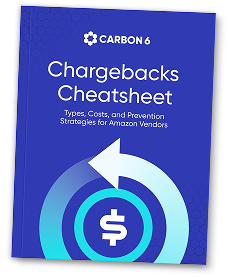
Automation Best Practices
Staying on top of your chargebacks can be a full-time job. As with many Amazon processes, automation helps. With the right automation solution you’re able to focus more of your time and energy on other, more nuanced elements of the vendor-Amazon relationship.
Beyond saving time and effort, leveraging automation expertise is a powerful way to elevate your recovery performance. Success depends on a solid grasp of the recovery process’s complexities, as well as the ability to execute each step swiftly and efficiently.
The right partner can handle this for you.
Making Lemonade
Here’s something you may not have considered: Amazon Vendor chargebacks can actually be used to predict future demand.
Yes, chargebacks are frustrating penalties, but savvy vendors can analyze the data to spot patterns in their supply chain.
Example. By identifying which chargebacks occur most frequently — for instance, late shipments or incorrect labeling — you can adjust your process to better align with Amazon’s expectations. Being proactive, analyzing the data for trends, you can optimize your process and even anticipate demand fluctuations.
Like making lemonade out of lemons, this is one way to turn a negative aspect of your vendor operations into a strategic advantage.
Your Strategic Partner
Carbon6 Revenue Recovery for Amazon combines automation with recovery expertise to manage chargebacks, shortages, and accruals deductions, disputes, and follow-ups to accelerate recovery while reducing internal lifts from teams.
Learn how Carbon6 can dispute Amazon vendor chargebacks on your behalf, taking your recovery to a new level of success.




